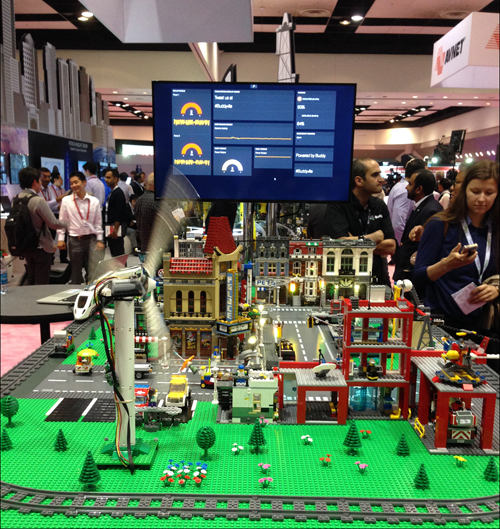Internet of Things vendors preached the importance of partnerships and working across industries, while the fire hose of new IoT platforms showed no signs of abating, with new ones from Hewlett-Packard Enterprise, Hitachi and SAP announced at the Internet of Things World conference, held this week in Santa Clara, Calif. Now in its third year, the event hosted more than 10,000 registered attendees and 200 exhibitors.
Platforms
Enterprise software giant SAP unveiled its SAP HANA Cloud Platform for the Internet of Things, which Nayaki Nayyar, SAP’s general manager and global head of IoT and innovation go-to-market (GTM), describes as a solution designed to help companies realize the outcomes they seek from deploying IoT technology. “There is a things layer and an outcome layer,” she says. “We address our customers’ concerns in terms of outcomes.”

By the things layer, Nayyar references the process of integrating sensors into machines, processes or discrete products, and this work is in the domain of the types of companies with which SAP partners to collect IoT-related data. But the outcomes include the integration of IoT data with other enterprise software products that SAP also offers on its HANA platform, such as the Customer Engagement and Commerce (CEC) Suite for customer relationship management and its Ariba software for tracking procurement and sourcing. “This integration is a key requirement for our customers,” she says.
Hitachi announced its own platform, called Lumada, at the event. Driven by Hitachi’s Insight Group, its new business arm addressing smart-city, industrial and manufacturing IoT applications—which it says generated $5.4 billion in revenue last year through 33 deployments—Lumada is pegged as the glue that companies in those verticals can use to bridge operational technology (OT) and information technology (IT) within an organization—which, in SAP’s parlance, would be the things and the outcomes.
The Lumada platform supports Hitachi’s various data collection and analytics software technologies, and is designed to help customers more quickly and easily enable their business objectives, such as using IoT technologies to improve their predictive maintenance, increase efficiencies or optimize business processes. Hitachi says Lumada will serve as the core foundation on which its customers’ IoT solutions are built.
But wait, there’s more. HP Enterprise, announced its Universal Internet of Things Platform. Its role in an IoT deployment is cast in a slightly different frame than SAP’s or Hitachi’s platforms, in that the Universal IoT Platform describes not just a unifying layer within a larger IoT deployment, but the sum of every discreet part, from connecting to gateways (which HP manufacturers) that collect sensor data to data analytics that process the information before sending it up to specific applications running on the platform.
Partnerships and LPWAN Buzz
In addition to each firm announcing their respective IoT platforms, SAP and Hitachi said they are forming a partnership aimed at bringing their combined IT and OT expertise to companies looking to deploy IoT-based solutions for manufacturing, smart-city, transportation and logistics applications.
Compal Electronics, an original design manufacturer of IT products, and Ingenu, which provides long-range, low-power wide-area network (LPWAN) communication technology for machine-to-machine systems for smart-city, logistics and industrial applications, are collaborating to bring Ingenu’s next generation of Random Phase Multiple Access (RPMA) communication modules to market. RPMA employs a proprietary RF modulation scheme and transmits up to 100 kilobytes of data per day to access points located at an average maximum distance of 25 miles, over the 2.4 GHz band. The second-generation module, called the picoNode, is smaller than a quarter, which opens up embedding options to smaller form factors.
Speaking of LPWA networks, Actility, which sells LPWAN devices using radios compliant with the LoRa Alliance‘s standard (developed by IBM and chipmaker Semtech), is partnering with myDevices, which sells software that uses protocol translators to connect devices virtually to an end user’s applications, business-intelligence platforms, marketing systems and analytics engines, in order to form an end-to-end IoT deployment. Through the partnership, the two firms hope to make it easier for their customers to integrate Actility’s networking equipment into infrastructure, such as streetlights or parking sensors, or into consumer products, such as sensors for smart-home applications, and then to create a platform with which to control the hardware and manage the data it generates.
LPWAN network provider Senet announced two network expansions, which it calls microcells, to complement its main (macrocell) public IoT network comprising more than 50 receivers deployed on towers around the United States that are receiving transmissions from LoRa modules mounted on fuel tanks and used to monitor fuel levels for automated refueling fleet scheduling. The microcells are being built out through the installation of gateways made by MultiTech and Kerlink, and will be expanded over time to support other gateway providers. Unlike the tower-mounted receivers, the gateways can be deployed quickly and cheaply, and are used to support specific applications such as monitoring the soil moisture or tracking assets for agricultural applications.
MultiTech, which manufactures wireless gateways for LoRa and other types of radios, said its MultiConnect Conduit LoRaWAN gateway will be deployed in the aforementioned Senet network microcells. The company also announced that its MultiConnect mDot LoRaWAN RF module and MultiConnect xDot module (an embeddable version of the module) now include Gemalto‘s Trusted Key Manager, a security and authentication chip. Used with a third-party security service running a key-management server on the Senet network, the Gemalto chip authenticates each module to prevent unauthorized modules from joining the network.
Editor’s note: An earlier version of this story incorrectly said the event had 4,000 attendees and 150 exhibitors. Those were 2015 figures. We regret the error.

